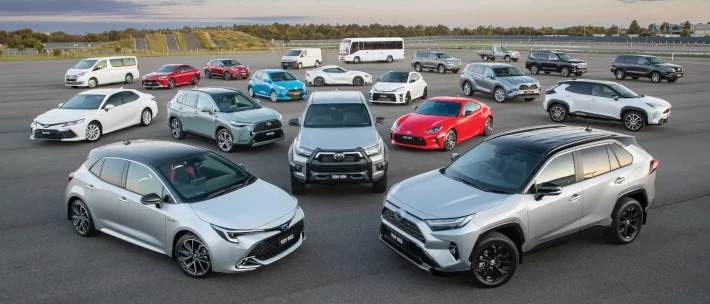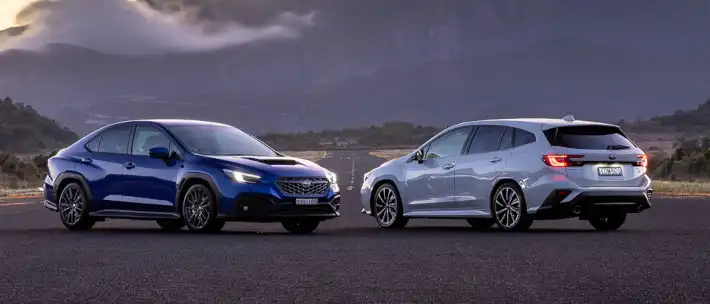It’s one of the most recognisable names in the eight-seat people mover segment, cementing itself as a benchmark over the course of its four generations, now.
Kia has made a number of key improvements to the Carnival platform, including an Australian-tuned suspension package, added equipment and the addition of a new hybrid version.
These upgrades have, however, been accompanied by some pretty steep price hikes, which begs the question of whether it’s worth upgrading all the way to the most luxurious version.
To find out, we got behind the wheel of the range-topping Kia Carnival GT-Line Diesel to see if it’s still worth the splurge or if you’re better served with a more affordable version.

Kia Carnival Competition
Kia Carnival |
VS |
Hyundai Staria |
| LDV Mifa | ||
| Ford Tourneo | ||
| Volkswagen Caravelle | ||
| Mercedes-Benz V-Class |
How Much Does the Kia Carnival Cost?
Prices for the MY26 Carnival range kick off from $50,570 for the entry-level Carnival S Petrol and $52,800 for the base model Carnival S Diesel and stretch out to $76,630 for the range-topping Carnival GT-Line HEV Hybrid.
Our review vehicle here, the Carnival GT-Line Diesel, is priced at $73,060.
Prices for the full MY26 Carnival range can be found below.
-
MY26 Carnival S Petrol - $50,570
-
MY26 Carnival S Diesel - $52,800
-
MY26 Carnival S Hybrid - $56,100
-
MY26 Carnival Sport Petrol - $56,470
-
MY26 Carnival Sport Diesel - $58,700
-
MY26 Carnival Sport+ Petrol - $62,800
-
MY26 Carnival Sport+ Diesel - $65,030
-
MY26 Carnival Sport+ Hybrid - $68,330
-
MY26 Carnival GT-Line Lite Petrol - $66,770
-
MY26 Carnival GT-Line Lite Diesel - $69,00
-
MY26 Carnival GT-Line Petrol - $71,100
-
MY26 Carnival GT-Line Diesel - $73,330 (tested)
-
MY26 Carnival GT-Line Hybrid - $76,630

How Much Can OnlineAuto Save You?
Using OnlineAuto’s car buying service, you could save thousands on your next car with the help of our team of car-buying specialists.
Get in touch with one of our Car Buying Specialists today.
Request a quoteWhat Features Does the Kia Carnival GT-Line Have?
The Carnival GT-Line sits at the top of the range and boasts a seriously long equipment list, leaving few buyers disappointed.
The list of GT-Line specific features is headlined by a set of dual projector LED headlights, a digital rear-view mirror, a remote start parking assist system, eight-way power-adjustable front seats with lumbar support and built-in ventilation, a heated steering wheel, a head-up display and wheel-mounted paddle shifters.

The Carnival GT-Line also picks up all the features you’ll find in lower grades, which means you’ve got a set of 19-inch alloy wheels, dual sunroofs, leather upholstery with heated front & rear seats, power-sliding side doors, a wireless charging pad and a 12.3-inch digital instrument cluster.
The list doesn’t stop there, though, because you’ll also pick up a surround-view monitor with front, rear and side parking sensors, a powered boot lift, dual-zone climate control, keyless entry & start, adaptive cruise control and Kia’s Highway Driving Assist 2 system.
As you can see, the list of features bundled into the range-topping Carnival GT-Line is close to never-ending.

Kia Carnival GT-Line Connectivity & Infotainment Features
The Carnival ticks some important boxes when it comes to in-vehicle tech.
All members from the entry-level Carnival S to the range-topping GT-Line pick up a 12.3-inch digital instrument cluster paired seamlessly with a 12.3-inch touchscreen infotainment system atop the dashboard with a slight curve angled toward the driver.
It’s a neat design that gives the Carnival a particularly high-tech vibe in the front of the cabin, while Kia’s operating system remains one of the best in the business, thanks to its user-friendly layout.
The 12.3-inch display is nice and bright, offering dynamic colours and is backed by some decent processing power to keep you sliding through menus.

Most of the Carnival range comes packaged with an eight-speaker sound system while the flagship Carnival GT-Line picks up a 12-speaker sound system courtesy of Bose.
A new addition to the MY25 Carnival range is the inclusion of the Kia Connect online services suite, which offers over-the-air updates, remote vehicle controls and diagnostics, emergency calls, connected navigation and more.
Does the Kia Carnival Have Wireless Apple CarPlay & Android Auto?
Potential buyers will be pleased to know that the Carnival’s infotainment system offers wireless smartphone mirroring for both iOS and Android ecosystems.
That means that buyers opting for the entry-level Carnival S all the way through to the range-topping GT-Line can leave the USB cables at home, thanks to Kia’s wireless Apple CarPlay & Android Auto offerings.
In our time behind the wheel, pairing our iPhone with Kia’s wireless Apple CarPlay was a quick and simple process, provided a stable connection and was extremely quick in connecting with our phone upon starting up the vehicle.

Is the Kia Carnival Comfortable to Drive?
While some might be a bit intimidated by the Carnival’s large footprint, it’s a smooth and user-friendly little giant on the road.
Kia has done an extremely good job when it comes to making its five-meter family monster an approachable package on a daily drive, which certainly helps to widen its appeal as one of the best family-movers on the market.
In MY26 form, buyers have the choice of three powertrains: a V6 petrol, a turbo-diesel and a new hybrid unit.

Our test vehicle comes powered by the most popular drivetrain, the 2.2-litre four-cylinder turbo-diesel that produces 148kW of power and 440Nm of torque, paired with an eight-speed automatic transmission powering the front wheels.
The diesel is the better engine by a country mile over the V6 petrol, offering more torque and significantly better fuel efficiency, though we can’t wait to test out the Carnival HEV to get a grasp on all three.
On the road, the Carnival’s turbo-diesel beating heart provides ample torque while picking up the pace in a smooth, stable manner.
Arguably, the biggest downside of the Carnival is its sheer stature on the road, best exemplified by how big it feels in a cramped car park, but the wide array of cameras and sensors help to ease the burden.

That said, the Carnival’s steering rack is easy to throw around, while the turning circle is pretty decent, too, meaning it’s not as cumbersome as you might expect.
Dawdling around town, the Carnival is happy to dart around, to the best of its abilities, while tackling roundabouts and traffic, meaning it doesn’t feel like such a family-friendly tank on the road.
All up, it’s a pretty easy package to navigate the urban jungle on the daily.
This is made even better by the fact that, thanks to some noticeable suspension tweaks, the latest Carnival range is by far the most comfortable and versatile option for Australian buyers.

These have culminated in a large, people-mover platform that is both easy to drive around town and remarkably smooth and comfortable while tumbling up a rough B-road thanks to the Aussie-tuned suspension hardware.
We were staggered with just how well the Carnival was able to soak up punishment on a country road while remaining nice and planted in the corners, though there’s certainly no hiding its weight if you really push it.
Thankfully, these improvements have carried over to the urban driving experience, too, where the Carnival has become an even more refined package while bumbling through town.
To round-out its jack of all trades nature, it’s also a damn comfortable long-distance cruiser that left us feeling as though there’s nothing it can’t do on a mix of road conditions here in Australia.

Is the Kia Carnival Fuel Efficient?
As we’ve mentioned, Kia now offers the Carnival range in 2025 with a choice of three engines, with the V6 petrol by far the thirstiest.
Kia’s 2.2-litre turbo-diesel is by far the company’s best-selling engine for the Carnival, thanks to its torque and very healthy fuel economy figures for a near 2.2-tonne, eight-seater family spaceship.
On paper, Kia says the Carnival Diesel range is rated at 6.5L per 100km on a combined cycle, which is a seriously impressive figure for the capability.

In our time behind the wheel, we averaged 6.8L per 100km over 820km-worth of town, country and highway driving, proving that it’s an easy feat to match Kia’s official figures.
For reference, Kia’s V6 petrol is rated at 9.6L per 100km, while the Carnival HEV Hybrid sips a more responsible 5.8L per 100km on the combined cycle.
All things considered, while the added efficiency boost certainly helps the Carnival HEV’s appeal, the difference isn’t massive between the hybrid and Kia’s turbo-diesel unit, which is something that price-conscious buyers might like to see.
-
Carnival V6 Petrol Fuel Economy: 9.6L per 100km
-
Carnival Diesel Fuel Economy: 6.5L per 100km (claimed)
-
Carnival Diesel Fuel Economy: 6.8L per 100km (tested)
-
Carnival HEV Hybrid Fuel Economy: 5.8L per 100km

Is the Kia Carnival Practical and Spacious?
The Carnival remains the final word when it comes to family-friendly practicality - it’s a serious game-changer for large families.
In more premium versions, the Carnival also becomes pretty sleek inside for a family mover, with leather upholstery and heated front & rear seats making their way onto the spec sheet.
It remains a benchmark for family-friendly packaging, thanks to its huge footprint and seriously clever and flexible interior design that allows you to configure a cabin layout tailored to your family.

Climb aboard and the Carnival’s cabin is very welcoming for drivers big and small.
The pilot’s seat is fully adjustable, offering tonnes of headroom for taller drivers and a nice elevated position for more petite drivers, with both reach and rake adjustments for the steering wheel.
There are some soft touchpoints for your elbows, which make all the difference on a long haul up the highway while the front seats are supportive and comfortable, with lumbar support on for the driver.
The layout of the dashboard is clean and simple in equal measures, with Kia’s dual-function touchscreen offering both media and climate controls with a single panel.

Separating the driver and front passenger is a substantial centre console with a nice raised elbow pad, housing a narrow tray, two cupholders and an extremely large, rubber-lined pad separated in two halves, one of which houses the wireless charging pad.
The passenger’s side of the centre console also receives a compact little storage nook alongside the usual suspects like a glovebox and some seriously large door bins.
Move to the second row and things get even more impressive, especially in variants with the power-sliding doors that mean your kids won’t get you in trouble in a tight car park.

Space is abundant in the back of the Carnival, with acres of leg and headroom that will keep tall adults happy, let alone kids.
Better yet, the second-row seats sit on their own set of rails, allowing you to slide them back and forth, with a neat middle-seat design that incorporates a neat little tray and cupholders when it folds forward.
Depending on the size of your family, you might also want to remove the middle seat entirely, providing a pretty luxurious four-seater layout in the second and third rows with easy access while unloading.
Amenities in the rear include dedicated air vents, USB-C charging ports in the seatbacks, bottle holders and some sun shades that pop out of the door sills.

Ready for the party piece?
Slide the second row seats forward and you can throw adults in the rearmost of the cabin and, in most cases, their knees won’t even be banging up against the seatbacks.
WIth plenty of width for kids sitting three-abreast, the Carnival is quite the feat of interior packaging, with easy access in and out of the third row and amenities coming in the form of air vents, four cupholders, USB-C ports and some sun shades.
For the parents out there, you’ll be pleased to know that the Carnival can accommodate a total of four child seats with its four pairs of ISOFIX anchors in both the second and third rows, with five top-tether mounts.
As you can see, the Carnival doesn’t even blink when tasked with families of eight, asserting itself as one of, if not the most practical vehicles you can currently buy in Australia.

How Big is the Kia Carnival’s Boot?
Typically, in a seven or eight-seater package, boot space ranges between marginal and non-existent.
Not in the Carnival, though, where the clever third-row seat mechanism pops out and has allowed engineers to further dig through the boot floor, meaning there’s some serious boot space on offer, even with eight seats standing.
With all three rows standing, the Carnival’s boot measures a barely believable 627L.

Fold down all the seats and you’ll unlock a total of 2,827L of boot capacity when it’s time to lug around bulky items which, thanks to the wide cabin design and tall roofline, means you’ve basically got a cargo van at your disposal.
The Carnival’s boot also offers a pair of nifty little storage shelves on the left-hand side of the cabin, several tie-down points and bag hooks.
Better yet, the Carnival range, except the HEV Hybrid, offers all this boot space capacity and bundles in a spare tyre, too.
-
Carnival Boot Space Minimum: 627L
-
Carnival Boot Space Maximum: 2,827L

Is the Kia Carnival GT-Line Safe?
All members of the Carnival range pick up a lengthy safety equipment list, while some key additions come to buyers upgrading to the Sport+ and above.
The range comes packaged with autonomous emergency braking, with pedestrian and cyclist detection and junction assist alongside adaptive cruise control, lane-departure alerts with lane centring, rear cross-traffic alerts, blind-spot assist, trailer stability control, multi-collision braking, speed limit assist, rear occupant alerts, a rear-view camera with front & rear parking sensors and curtain airbags.

Buyers stepping up to the Carnival Sport range pick up Kia’s Highway Driving Assist I system, while Sport+ variants receive Highway Driving Assist II.
The Carnival Sport+ and above also receive rear cross-traffic assist, a surround-view monitor with side parking sensors, a blind-spot view monitor, rear autonomous emergency braking and junction cross, lane oncoming, and lane direct avoidance systems.
All up, the base model comes packed with all the absolute necessities for active safety tech, while buyers upgrading to a higher-ranking variant receive a tonne of clever technology to sweeten the deal.

Does the Kia Carnival Have an ANCAP Safety Rating?
The Kia Carnival has been awarded top marks from ANCAP, scoring a five-star rating during its 2021 testing.
-
Adult Occupant Protection: 90%
-
Child Occupant Protection: 88%
-
Vulnerable Road User Protection: 68%
-
Safety Assist: 82%

What Warranty Does the Kia Carnival Come With?
Kia continues to offer its confidence-inspiring seven-year/unlimited-kilometre warranty with the MY25 Carnival range.
Drivers also pick up a 12-month roadside assistance subscription, which stretches out another 12 months when you keep it serviced within the network.
In terms of servicing, Kia offers capped-price servicing for the Carnival range in petrol, diesel and hybrid form.

Capped price servicing prices for all three engine options can be found below.
-
Kia Carnival Petrol Seven-Year Servicing Costs: $3,897
-
Kia Carnival Diesel Seven-Year Servicing Costs: $4,157
-
Kia Carnival HEV Hybrid Seven-Year Servicing Costs: $4,597
It’s worth noting that service intervals drop from 12 months / 15,000-kilometres in the petrol & diesel versions to 10,000-kilometres for the Carnival HEV Hybrid.
Our Verdict: Is the Kia Carnival GT-Line Worth it?
We’ll come right out and say it - there is no better vehicle on the market for large families, especially on the value front in low-spec versions.

While the range-topping Carnival GT’s value proposition isn’t quite as strong, you pick up a lovely cabin with premium materials and a seemingly never-ending features list that makes it a worthwhile option for family buyers looking for a premium people-mover.
Kia’s close attention to the family-centric user experience makes the Carnival an infallible family mover that not only shows up its SUV competitors, it puts them to shame to an embarrassing degree.
We welcome the addition of a hybrid version of the Carnival, though considering the difference isn’t quite night and day, we’d say skip the V6 petrol, stick with the turbo-diesel engine and pick a trim level that aligns with your need for premium touches.
Don’t forget that our team of car-buying specialists is waiting on hand to help get you the best possible deal on your next car.

Five Kia Carnival Specs You Need to Know
-
Seven-year/unlimited-kilometre warranty'
-
Three engines available - petrol, diesel & hybrid
-
Four separate ISOFIX child seat anchors
-
627 - 2,827L boot space
-
Five-star ANCAP safety rating (tested 2021)
Get in touch with one of our Car Buying Specialists today.
Request a quote








